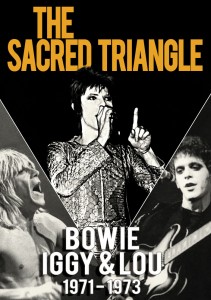Documentary fails to show the musicians’ perspectives
Though almost 40 years have passed since his monumental rise to rock stardom, there still exists an impenetrably mysterious aura that surrounds glam rock star David Bowie.
His dazzling stage costumes, his fascination with the intergalactic unknown and his ever-changing stage personas have all been given limited explanation over the years by the typically reserved rocker.
British film studio Sexy Intellectual tackles the daunting task of crafting a documentary that illuminates not only the historical factors behind Bowie’s successful reign in the music world, but also that of rock industry giants Iggy Pop and Lou Reed.

Glam · The Sacred Triangle shows how David Bowie, Iggy Pop and Lou Reed came together to craft their unique rock ’n’ roll images. - Photo courtesy of MVD Entertainment Group
By intertwining the three stories to show the inspiration these three men drew from one another in crafting their stage personas, The Sacred Triangle: Bowie, Iggy & Lou: 1971-1973 attempts not to reveal the myths behind this holy trinity of rockers, but to allow viewers to gain a greater appreciation of each artist’s revolutionary work.
Beginning with concert footage of Bowie’s 1973 show at London’s Hammersmith Odeon in which the glam rocker, through his stage alter ego Ziggy Stardust, announced his retirement from the musical world to a devastated crowd, The Sacred Triangle moves back in time to recount Bowie, Iggy and Reed’s story through interviews from various sources, including Bowie’s ex-wife, Angie Bowie.
Acting as both Bowie’s wife and biggest fan during his frustrating early years as a musician, Bowie notes that her ex was so desperate to be a star that he would play shows solo when he could not put a band together.
Bowie’s artistic reinvention occurred while he was in the audience of Andy Warhol’s controversial play Pork, a show that interviewee Dave Thompson described as “a bunch of New York freaks running around naked, [defecating] on one another.”
The documentary trumpets Warhol’s influence in the eventual collaboration of the three musicians. Warhol’s Factory assistant, Billy Name, gave a behind-the-scenes description of Warhol’s decision to catapult Reed’s band, The Velvet Underground, into stardom by first featuring the group in his multimedia show “Exploding Plastic Inevitable” and eventually producing its first studio album.
On another front, Iggy Pop — depicted through images, old concert footage and firsthand accounts as a wildly out-of-control rockstar — nearly lost his music career to drugs. One interviewee recalled a certain episode during the production of Iggy Pop and The Stooges’ second album in which the star was dropping acid every day.
After The Stooges’ breakup, it was Bowie who took the troubled Iggy under his wing, taking lessons from the drug-addled rocker’s deeply charismatic appeal while also marketing Iggy as a world-class musician who deserved a second chance.
Sure, The Sacred Triangle boasts compelling history and fascinating stories, but the end result is a surprisingly tired and disappointing documentary. It seems almost antithetical that a film about colorful rock stars that sang about sex, drugs and space was constructed in such a formulaic, repetitive manner.
Tales of Iggy’s drug abuse problems, Bowie’s obsession with fame and Reed’s collaboration with Warhol can only keep the audience’s attention for so long. Moreover, viewers are teased with extremely brief song snippets and concert footage scattered throughout but never get the satisfaction of seeing extended clips of the stars in action.
The documentary’s worst crime, however, is that though it boasts the iconic names Bowie, Iggy and Lou, their presence and input in the film is sorely lacking. Bowie’s ex-wife’s comments on the rock star’s revelation of his bisexuality as simply a marketing tool, yet the viewer is left wondering about the rocker’s thoughts and his reasons for fusing his bisexuality with a measure of androgyny to create Ziggy Stardust and the music that followed.
Geared primarily to music academics and hardcore fans, The Sacred Triangle will no doubt educate its audience on a period of drastic change in the music world. Yet, viewers who stumble upon the documentary because of their intrigue toward the three mythical rock figures will leave dissatisfied.
The academic approach to the topic is admirable, however, a much more unconventional approach is necessary to tackle such a strange and remarkable story.
